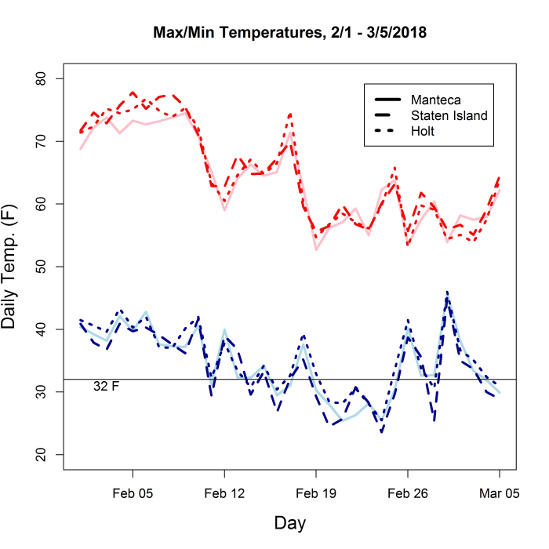By Michelle Leinfelder-Miles
Fig. 1. Yellowing and tip burning of wheat from frost injury.
I have received a couple inquiries from Pest Control Advisors about wheat that is showing leaf tip yellowing and burning (Fig. 1). Their suspicion is frost injury, and with the weather we have experienced over the last several weeks, their suspicion is likely true.
There isn't a hard-fast rule of when frost injury will occur because several factors influence its occurrence and severity. The factors include the temperature but also the duration of cold exposure, the plant growth stage, and the growing conditions. The UC
Small Grains Production Manual (see page 101) states that injury may occur with temperatures at or below 35⁰F and that even just a couple hours of exposure is enough to cause injury.
Below (Fig. 2), I present temperature data from the last month from a few local CIMIS stations. Remember that in early-February, daytime highs were getting above 70⁰F. By mid-February, however, minimum temperatures were low enough to cause frost injury, and hourly data (which I am not showing but is available from the CIMIS website) shows that temperatures below 30⁰F often spanned several hours over many nights in late-February.
The plant stage of development is critically important to how a crop may be injured from frost and how it may overcome injury. At tillering, leaf yellowing and tip burning will be the obvious symptoms. At this stage, however, yield impact will likely be slight, if any. That is because the growing point of the tillers is close to the soil and protected from the cold. When warmer weather resumes, the plants may be able to continue tillering, particularly in thin stands where there is space to fill, and overcome the injury. In the jointing stages, in addition to the leaf yellowing and tip burning, some leaf or stem lesions may be apparent. There could be moderate impacts on yield if the growing points of the tillers have been injured. Look for a chlorotic or dead leaf in the whorl. Also, try splitting the stem with a razor blade at the growing point. This picture from Texas A&M University shows how to do this. If the growing point (at the arrow) appears white, brown, or water-soaked, then there has been frost injury. Once the crop gets into the reproductive stages of growth, it becomes more sensitive to injury with bigger repercussions for yield, but luckily, I think most of the fields in our region aren't yet to these later stages of development.

Fig. 2 Recent temperature data from three San Joaquin County CIMIS stations.
Keep in mind that there are field and other growth conditions that may lessen or worsen the severity of frost. Low parts of the field where cold air settles will likely show more injury. Fields that were planted earlier in the fall, or earlier-maturing varieties, that are in a later stage of growth will likely show more injury. Crops that have had good moisture and nutrient conditions may also show more injury. With one of the inquiries I received, the field had been fertilized about a month ago, and given the warm daytime temperatures we had at that time, those plants were likely resuming growth and probably got hit by the frost all-the-more. Crops that have been moisture stressed, however, may have been hardened and not show as much injury.
So, what now? Again, growers and consultants with crops in the jointing stages who are seeing leaf tip yellowing may wish to split some stems to observe whether there has been injury to the growing points. If this has occurred, there is nothing that can be done to “save” those tillers, but it might provide some insight into potential yield impact. If stem lesions appear, be on the look-out for disease infections but also lodging later in the season. Unfortunately, the most telling symptom will appear after heading when grain doesn't fill. Don't hesitate to reach out to me or your local farm advisor if you have questions about frost injury.